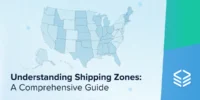
Two of the most popular options for selling products online are on an independent ecommerce website or an online marketplace platform that brings together multiple sellers. Deciding which one is right for your brand is one of the first decisions you’ll have to make before making your first sale.
Just like each channel has its own benefits and downfalls, each brand will have its own calculus to do when deciding whether to go the marketplace or ecommerce route.
What is an ecommerce platform?
Ecommerce is the buying and selling of goods and services through an online store or transaction. When we talk about retail, an ecommerce platform is the digital storefront, usually a website, where consumers go to purchase products. On an ecommerce platform, only one brand or retailer sells their products and handles every aspect of the purchasing process for their online business, from advertising and handling overflow storage to shipping and assisting in the return process.
What is a marketplace?
In many ways, a multivendor marketplace is an evolution of the traditional ecommerce storefront. A marketplace allows multiple brands to sell their products through the same online storefront, and the store owner commonly sells its own products alongside the third-party sellers.
An example of a marketplace is the Amazon marketplace. Amazon has its own products listed right along with products from multiple vendors. Some other popular marketplaces include eBay Ebay, Etsy, and Walmart. Etsy alone has 3 million sellers and more than 50 million customers. Discover how Flowspace can help with your Amazon, eBay, Etsy, or Walmart Marketplace integration needs today.
Retailers like 1800 Flowers, Bed Bath & Beyond, Kroger, Macy’s, and more are increasingly establishing marketplaces of their own, diversifying the retailers’ product mix and offering brands a new channel for discovery and growth.
The key to a marketplace is that the consumer has the same buying experience if they’re purchasing a product from the marketplace owner or another seller on the marketplace. A seamless, efficient marketplace fulfillment experience is necessary to ensure that shoppers have a positive experience and return to buy again.
Pros and cons of an ecommerce platform
As with anything, there are tradeoffs that come with selling products on an ecommerce platform. While a brand has complete control over the platform’s functionality, design, and navigation, it takes more time and money to build and maintain that platform.
While there is no on-site competition on an ecommerce platform (the consumers see only your products), the brand needs to work to attract and maintain customers as well as build its own brand awareness.
If a brand sells on its own ecommerce site, they won’t need to worry about restrictions and rules (that can apply when selling on a marketplace), but there’s more financial risk in growth. It can be expensive to scale up and expensive to scale back if the brand grows operations too quickly.
Another benefit to using an ecommerce platform is that the brand can build a customer list for marketing, which can be an invaluable way to increase potential customer engagement and repeat purchasing.
Pros and cons of a marketplace
Selling on a marketplace means a brand has access to every customer that shops on that online shopping platform, which means both traffic and customer engagement but also competition with every other seller on that platform.
Setting up sales on a marketplace can be quick and easy with low or no setup cost. This means there’s very little financial risk to a brand to start selling on a marketplace.
When selling on a marketplace, it can be harder to create brand awareness because customers often think of the platform first and the seller second, if at all. In a similar vein, a brand cannot build a customer list to use later for marketing purposes, which can be a big loss.
How to decide to sell on marketplace or ecommerce
Depending on its specific needs and goals, deciding whether a marketplace or ecommerce is the best place for a vendor to sell will vary from brand to brand and even at different points in a brand’s growth trajectory. For example, selling on a marketplace can be an easy and low-cost way to start building a brand. That same brand might decide to launch its own ecommerce site later on to have more control and more ability to build brand awareness.
Brands might also decide to sell on both—known as multi-channel. Using a third-party logistics company provides brands one place to keep track of sales across channels and provide a seamless experience for customers. The Flowspace platform provides an all-encompassing, integrated command center, organizing your ecommerce and marketplace fulfillment network, orders, inventory, customer insights, and more. With a connected, distributed network and software that integrates with all your online sales channels—whether they are marketplace or ecommerce or both —Flowspace is the fulfillment solution where any ecommerce company can take control of their operations.
Having a technology that accounts for network optimization, plus integrates with popular ecommerce platforms and popular marketplaces is an invaluable tool as your brand grows and your strategy evolves to bring in any potential buyer.






